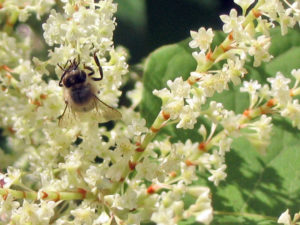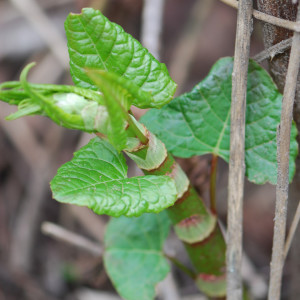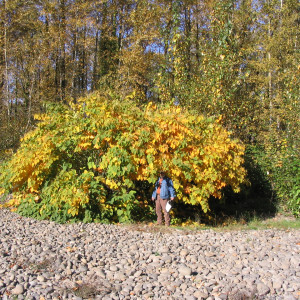September is the Time to Control Japanese Knotweed
Japanese knotweed (Fallopia japonica) has been called a “nightmare” and a “botanical bully,” and is one of the 100 worst global invaders. These characterizations give you a pretty good idea of just how unwelcome this invasive weed is in our community.
Japanese knotweed is fast-growing and hardy, native to Japan, China, and the Korean peninsula, and was introduced to the United States in the 1800s as an attractive ornamental. But don’t let the heart-shaped leaves, bamboo-like stems, and pretty, small white flowers fool you! It is a menace with many infestations in Oregon, including much of Clackamas County.
Also known as “Mexican bamboo” and “fleece-flower”, Japanese knotweed is an Oregon Class B noxious weed. This means it is a weed of economic importance which is regionally abundant but may have limited distribution in some Oregon counties. It also means that the propagation, transport, and sale of this plant are prohibited by law.
Japanese knotweed is an herbaceous perennial. It is most frequently found along streams and rivers, where root fragments, seeds, or pieces of the plant’s green stalks were washed downstream by the current, creating new infestations. It is also commonly found yards and gardens, where unsuspecting homeowners planted knotweed, not realizing its potential for damage. From these introductions, it continues to spread to roadsides, forest edges, and vacant lots.
This fast-growing invasive weed can have an annual growth of up to 10 feet. Stems are green to reddish-brown and hollow, segmented similar to bamboo, but are much weaker. It has alternate, leathery, thick, triangular-shaped leaves. Flowers are greenish-white to cream in large plume-like clusters at the ends of the stems. They bloom from late July to October.
Why Should I Care About Japanese Knotweed?
 Japanese knotweed spreads quickly along streambanks and in wetlands where it forms tall, dense stands that compete for light and resources. This harms our native plants which provide valuable food and habitat for pollinators and wildlife.
Japanese knotweed spreads quickly along streambanks and in wetlands where it forms tall, dense stands that compete for light and resources. This harms our native plants which provide valuable food and habitat for pollinators and wildlife.
Knotweed also competes with important native streamside vegetation. Unlike our native riparian plants, knotweed dies back each winter leaving streamside soils exposed. This leads to increased erosion of the streambank, which in turn damages fish habitat and the nutrient cycles within streams. Salmon are particularly impacted by the damage done by Japanese knotweed.
Knotweed grows not only from seed but also by root and stem fragments. Even the smallest fragment of a stem or root from Japanese knotweed can yield an entirely new colony downstream. To make matters worse, Japanese knotweed will grow even more quickly and densely in response to cutting, so many well-meaning landowners have unknowingly increased its spread in their attempts to control it.
Additionally, Japanese knotweed decreases property values due to the potential of asphalt, concrete, or foundation damage from the rhizome, as well as the long-term investment in the management of the plants.
How Can I Control Japanese Knotweed?
Getting rid of Japanese knotweed is not easy and requires a persistent effort to be successful.
Manual and mechanical approaches for controlling knotweed combine cutting, covering, and digging. These approaches focus on starving the knotweed of sunlight and removing as much material as possible. These approaches are very labor-intensive and require regular and repeated effort for success. Due to the massive time and effort involved with these practices, they are only recommended for very small infestations.
When cutting or digging out Japanese knotweed, plants should be bagged up and disposed of as trash. They can also be piled up and dried before burning, but a barrier should be placed between plants and the ground to prevent re-rooting. Pulled or dug knotweed should not be composted as this can spread it to new areas.
For larger knotweed patches, herbicides are one of the few tools that can be effective. Even with herbicides, careful timing is important to ensure success. September is a perfect time to control Japanese knotweed. Time herbicide applications just as its leaves are starting to turn from green to yellow. During this time, the knotweed plants are pulling energy from the back down into its roots system. This makes it more susceptible to the effects of herbicides. A carefully timed herbicide application can provide superior control to any other control methods. A landowner guide to controlling knotweed is available to learn more about these strategies.
Successful control of this invasive weed will take more than one year. While there are mechanical or manual control options for small patches, large sites will almost certainly require integrating herbicide use into your control strategy. For more information on how to control Japanese knotweed, please check out our knotweed brochure or contact us for more information.
Report Japanese Knotweed!
Have you noticed invasive Japanese knotweed in your area? If so, please report your sightings to the Oregon Invasive Species hotline or contact us directly. Your help in identifying and reporting locations of Japanese knotweed in our community will help to stop the next invasion before it starts!
For more information about knotweed check on these resources:
-
Biology and Management of Knotweeds in Oregon
-
Knotweed Best Management Practices: Columbia Gorge CWMA
-
Plants Profile for Polygonum cuspidatum (Japanese knotweed)
-
Knotweed profile – State of Oregon
-
Knotweed– Washington State Noxious Weed Control Board
-
Invasive Species Compendium Datasheet- Fallopia japonica (Japanese knotweed)
-
King County Noxious Weeds: Japanese knotweed Best Management Practices
-
Weed Research & Information Center: Japanese knotweed Weed Report
-
Controlling Knotweed in the Pacific Northwest



